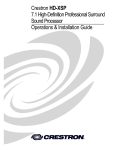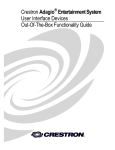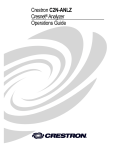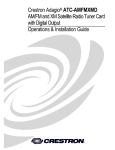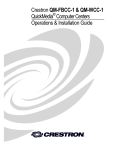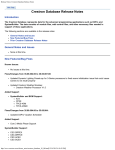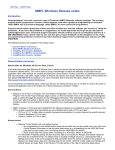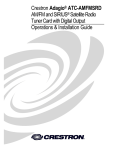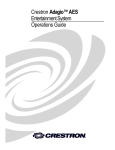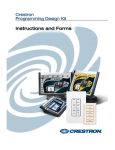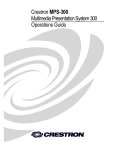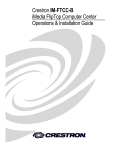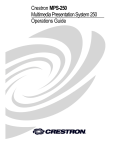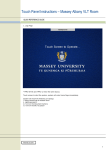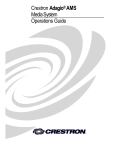Download Crestron SystemBuilder v3.10.037 Release Notes I. Introduction to
Transcript
Crestron SystemBuilder v3.10.037 Release Notes I. II. III. IV. V. VI. VII. Introduction to SystemBuilder Additional Documentation Known Issues Revision History PC Requirements and Recommendations Installing SystemBuilder Installing other required software =-=-=-=-=-=-=-=-=-=-=-=-=-=-=-=-=-=-=-=-=-=-=-=-=-=-=-=-=-= I. Introduction to SystemBuilder Congratulations! You have received a copy of Crestron's SystemBuilder software package. Crestron’s SystemBuilder offers an easy way to create a complete control system project, concentrating on Prodigy, Sonnex, Adagio, iMedia, QuickMedia (including MPS/MPC), and Audio Distribution applications. The design aspect of SystemBuilder enables you to easily break each project up into areas and rooms. To each room you can add both Crestron and third party devices, as well as user interfaces selected from Crestron’s extensive lineup of touchpanels, keypads, and handheld remotes. The development aspect of SystemBuilder allows you to determine what actions occur when the user presses a button on a touchpanel, keypad, or remote. You can also program actions to occur based on time of day, or when a contact closure is detected. Programming is accomplished using a simple yet powerful user-interface. SystemBuilder also includes "Real Time" mode, an interactive way to control, test and debug your entire system from one intuitive environment. Finally, SystemBuilder allows you to document your project by creating attractive and easy to read reports. These reports are generated in HTML, meaning that they can easily be emailed, or imported into another application such as Microsoft Word or Excel for inclusion in a larger document. Crestron’s SystemBuilder is fully integrated with Crestron's suite of software development tools, including SIMPL Windows, VTPro-e, Crestron Toolbox, Crestron Engraver, and the Crestron Database. These tools work together to provide the link between Crestron system hardware, touchpanels, and the world of equipment to be controlled. Crestron has devoted a great deal of time and effort to make this software useful and effective. If you have any comments or suggestions, we would appreciate hearing from you by email at [email protected]. If you cannot email us, you can also give us your feedback via telephone or fax. If you are experiencing problems, Crestron's top-notch technical support team is standing by to help you at 1-888-CRESTRON. =-=-=-=-=-=-=-=-=-=-=-=-=-=-=-=-=-=-=-=-=-=-=-=-=-=-=-=-=-= II. Additional Documentation The following items were changed too late to make it into the online documentation: < None at this time > III. Known Issues • Important Notice for Users of Windows XP Service Pack 2: It has been discovered that Windows XP Service Pack 2 causes a memory leak with applications that use the Microsoft Foundation Classes (MFC). This can be seen by using Task Manager to watch the allocation of GDI objects by the application when child windows are created and destroyed. Since VisionTools™ Pro-e uses MFC it is affected by this issue and may eventually crash after a large amount of page views are opened and closed. This is especially true when using it through SystemBuilder. Microsoft is aware of this problem and has issued Hotfix KB319740 to address it. For more information and to download the patch, please see: http://support.microsoft.com/kb/319740/en-us • In Interface View and Programming View, in some instances it may be necessary to double-click on the interface image in order to be able to select buttons or engravable areas. • QuickMedia touchpanels are not yet modeled on the QuickMedia view. QM signals can still be sent to, and received from, QM enabled TPMC and TPS touchpanels. The functionality is there as long as the appropriate switching commands are programmed to route video to these panels. However, the QM touchpanel connection information will not be available for the generated documentation. • When opening projects created using a Crestron Database version prior to 18.7.8 that contain an ATC-AMFM2 or ATC-AMFMXM tuner card, the associated hardware modules will be updated automatically to take advantage of the new features of these devices. In the case of the ATC-AMFMXM the existing template will remain "C2N-TXM" even after the module is updated. So that the template matches the new module you should go to the Device Properties for the XM tuner and change the template name from "C2N-TXM" to "XM". To rebuild only the device pages for the XM tuner card without rebuilding the entire interface project, go to the Interface Properties, “Devices” tab, right click the XM tuner device and select the "Rebuild page(s) for this Device" pop-up menu option. Any custom programming external to the XM tuner card device pages that targets the XM tuner card device should be checked and corrected as necessary since the cue names for the new XM tuner card module may have changed from the old XM tuner card module. • If a project contains an AAS along with an AMS, AMS-AIP, AES, or one or more APADs, the AAS firmware must be upgraded to 3.0.1364.0 or later or the AAS control pages on the Front Panel and/or APADs will not operate correctly. This firmware, along with this version of SystemBuilder, also significantly reduces the system program size. • When clicking on an unfocused embedded VTPro-e page and immediately starting to drag an object, the drag operation will be interrupted as the page gains focus. • An issue exists with a project that contains one or more TPMC-8X interfaces if a SystemBuilder wizard using a version of VTPro-e prior to 3.7.x.x built the interface projects. When rebuilding those interface projects in a SystemBuilder wizard using VTPro-e 3.7.x.x, a dialog will be displayed stating that the associated .vtp file already exists and asking whether the project should be rebuilt. This is due to VTPro-e updating the TPMC-8X project for new supported features when SystemBuilder opens the project. The “Yes” button on this dialog should be selected. This dialog will only be shown the first time the project is rebuilt by a SystemBuilder wizard using VTPro-e 3.7.x.x and will be corrected with a future version of VTPro-e. • In PMC3-XP based Prodigy systems, APADs cannot currently be used to control Prodigy devices. These devices are: o Prodigy Audio Zone (Theater/AD Room) o PT-AMFMXM (both AMFM and XM tuners) o P-IDOCV • Dynamic Preset extenders, exported using the Remote Systems functionality, will work, but will only show the preset names, not the preset images, unless the imported Dynamic Presets extenders are configured to use the same preset image libraries as the source Dynamic Presets extenders. If this is done, the configuration of the Dynamic Presets extenders must be kept in sync manually between the source and import systems. =-=-=-=-=-=-=-=-=-=-=-=-=-=-=-=-=-=-=-=-=-=-=-=-=-=-=-=-=-= IV. Revision History V3.10.37 (Maintenance Release) • Fixed issues with new Remote Systems (RSD 3.0) functionality: o Remote System IDs not loaded correctly for imported presets o Remote mode plug-in activation logic failing to find the D3 Pro lighting plug-in o Non-exported devices still appearing in RSD list and in RSX file o Cue does not exist program generation warnings for imported Dynamic Presets extenders o Extenders tab not shown for imported devices – cannot configure Dynamic Presets extenders • Fixed: Touchpanels marked as not fully built after successful Build System • Fixed: Changing Run-Time Data Storage does not mark the program as dirty • Fixed: Unable to build interface after it was replaced • Fixed: Unused run-time data files not deleted from 3-Series control processor during upload • Fixed: Network Setup Wizard not using current Program ID Tag • Fixed: Program IT Tag is blank until a new system is saved • Fixed issues with European regional settings using a comma as the decimal separator: o Fixed: “Failed to initialize view … Type mismatch.” Error o Fixed: Delay/Pulse times <1s set to 0.01s V3.10.036 • Incremental program generation o Support added in SystemBuilder, not in any wizards (yet) o Update System button appears on Finish View o Initial Full Build required in any SystemBuilder session o Replace Control System will require a subsequent Full Build o Changes to touchpanel interface projects (.vtp) will perform some small incremental program generation, even if the items changed do not affect the program (i.e., unjoined pages/objects) o For certain programming step types (listed below), an additional subsystem is created in the generated SIMPL Windows program per step. Each additional subsystem requires a symbol handle, which can cause some large programs, already near the symbol handle limit for SIMPL Windows, to become too large, and require refactoring to reduce the symbol handle usage. Programming step types that add an additional subsystem: • Analog commands • Serial commands • Run Global Preset • Set Serial variable • Conditional commands • Connect commands • Set variable device Programming step types that do not add an additional subsystem: • Digital commands • Press Button commands • Cancel Global Preset • Set Digital variable • Set Analog variable • RSD 3.0 o Export creates associated .RSX file which contains additional information used on import o Import without .RSX file prompts the user for the associated .csb or .d3p project file o Imported remote devices get added to local rooms of the same name and appear to be local o Currently known issue: The CEN-TRACK tuner cards (AMFM2, AMFMXM, AMFMSR) and the AAS devices (all models) cannot be exported and controlled by an APAD on the remote system. They can be exported and controlled by any other interface on the remote system. • Sonnex support: o New Sonnex Audio Distribution plug-in o New Room Properties->Audio Distribution tab (identical to Prodigy PAMP systems) New Device Properties->Switching tab (identical to Prodigy PAMP systems) New System Properties->Groups tab (identical to Adagio groups with the following exceptions): Each group has a limit of 12 rooms Volume Tracking is on a per-group basis instead of a global setting across all groups o New System Properties->Switcher tab Allows selection of Ethernet (default) or Cresnet version of SWAMP o Two devices (SWAMP System and SWAMP AV System) are added/removed with the SWAMP These devices are included to support custom programming o Audio Settings button on Finish View launches new Sonnex Tool application Prodigy enhancements: o Added new Prodigy control processor/interface configurations: PMC3+ – for new PMC3 control system configuration with PTX3 PMC3-XP – for new PMC3-XP control system configuration with no interface o Added support for Prodigy P-CBDCN, P-CBDEX, and P-KPLEX keypads: Default engraving/programming for audio & lighting keypad layouts for P-CBDCN/EX Default engraving/programming for lighting keypad layout for P-KPLEX Keypads supported in both Prodigy Composer and SystemBuilder Prodigy systems o Allow a Display Device to be added to the Theater room without enabling Theater support Prompt is issued when adding a Display Device to the Theater room with no Receiver User response will determine whether Theater support is enabled or not o Remove requirement that Theater sources must have switching commands set – any device with a Receiver/Theater Display Device set is considered a Theater source Done automatically for all devices added on the Sources tab in Prodigy Composer Set in SystemBuilder on the Device Properties->Switching tab o Expose Source Commands as user programmable events on the Programming View o Added Display/Receiver powerup time input field to: Receiver/ Display Device tabs in Prodigy Composer Display Device Zone/Two-Zone Volume extenders in SystemBuilder o Filter available devices by control system – only show applicable library devices o Added US/International mode – only show appropriate regional library devices Regional setting is saved on the computer, not in the project Cannot be changed while a project is open Option available on Prodigy Composer welcome screen Option available on SystemBuilder Preferences dialog, Advanced tab o Added new Source Selection tab/dialog: Available as a dialog from a button on the main form of the Prodigy Composer Available as a tab on the System Properties dialog in SystemBuilder o Added new Multicast device to allow dynamic intercommunications between Prodigy systems Included in all new Prodigy Composer systems Can be added in Prodigy SystemBuilder systems Prodigy Composer enhancements: o Added support for P-CBI/CBI-WIRED keypads with audio layouts on Audio Keypads tab o Added support for P-CBDCN/EX keypads with audio layouts on Audio Keypads tab o Do not turn on Display Device when an audio only source is selected Audio only source is a device without a Display Device switching command selected o Added comments to Display Power On/Off global presets describing location of power up time o Added ability to remove a Receiver/Display Device on their associated tabs o Added support for additional lighting devices on Lighting Control tab o Added “Enable Lighting for this Room” checkbox to enable/disable room lighting functionality o Added new System Options tab to allow inclusion of Weather device o Included new Multicast device in all new Prodigy Composer systems For Adagio and Audio Distribution (AD) systems: o Expose Source Commands as user programmable events on the Programming View Adagio Composer enhancements: o Added “Enable Lighting for this Room” checkbox to enable/disable room lighting functionality Enhanced program generation logic: o Do not to add symbols unless needed, (instead of adding them and deleting them later) Added support for Crestron multi-zone lighting devices o Lighting rooms for individual loads can be selected on the Device Properties->Properties tab o o • • • • • • • • • • • • • • • • • Added support for new “3-series” control systems o Added Program ID Tag dropdown on System Properties->General tab Added Finish View button for all systems to launch Network Setup wizard Added support for the ATC-AUDIONET card Added Child Endpoint Device frame on IO Assignment tab of Properties dialog for devices that have a child device with its own I/O Assignment settings, to bring up the Properties dialog for the parent device Added support for commenting out a programming step Fixed: Using “Edit Session…” in Upload dialog prevents synchronization, dynamic presets, and scheduler files from uploading to the control system Fixed: Analog cues from UI modules cannot be used in expressions Fixed: Property value out of range error message does not display values in the correct units Fixed: Control/Equipment ID parameter not getting set on Sirius tuner card module Fixed: User IR file cannot be added to Adagio projects Fixed: System device does not have a single Startup event for use to do initializations on program start V3.09.31 (Maintenance Release) • Enhanced program generation logic: o Mark subsystems for deletion if they do not include undeleted symbols o Trigger symbol cleanup during generation of large programs • Fixed: XM Tuner pages always get removed from all interfaces when opening AADS-XM projects V3.09.29 (Maintenance Release) • Added basic support for Prodigy P-CBI and P-CBI-WIRED International keypads: o Default engraving/programming for five (5) different keypad layouts: Two (2) Lighting only; One (1) Audio only; Two (2) Lighting/Audio o Keypads supported in both Prodigy Composer and SystemBuilder Prodigy systems o Keypads with audio layouts not supported on Prodigy Composer Audio Keypads tab Changes to source select button devices must be done in SystemBuilder • Added TPMC-4SMD and MTX-3 as available interfaces for all control processors in Adagio Composer • Fixed: Cut/Copy of interfaces with interlock groups with names > 18 characters long causes crash • Fixed: Logic removed on digital joins assigned to touchpanel projects when rebuilding the project • Fixed: Program generation assigning the same signal names to all AAEs in the project so they all operate in sync (e.g., turn on Room 7, and Rooms 13 and 19 also turn on) • Fixed: Programming signals cannot be applied to module cues which have default values set • Fixed: Group Volume Tracking checkbox not available on AADS/AADS-XM systems • Fixed: Adding a Sideshow device generates an incomplete program • Fixed: Rename of a device while having slave lighting in the project causes crash • Fixed: CLW-SLV-P incorrectly shown as an available lighting interface in Adagio Composer • Fixed: Opening existing AADS-XM projects correctly updates template page value for XM Tuner device, but does not remove the old and add the new XM Tuner pages in existing touchpanel projects • “Read-only” Engraver interfaces shown in “Order Engravings …” dialog • Fixed: Interrupt Volume slider not available on AADS/AADS-XM custom real-time control • Fixed: Crestron Mobile Pro, Crestron Mobile Pro G, and XPanel for Mac projects not obeying the value of the “XPanel Browser Data Storage” (now “Web Mobility Data Storage”) System Properties option V3.09.26 (Maintenance Release) • Fixed: User serial devices (.umc) using device code 134 (Crestron DB serial-controlled device) were being incorrectly identified as located on an IR port in the Device Properties->IO Assignment tab v3.09.25 (Maintenance Release) • Fixed: Crash when editing conditional expressions • Fixed: European_Tuning signal not connected to source modules from Adagio protected module • Fixed: “Set Button Text” menu item enabled for P-CBD-AD/AD-WIRED keypads • Fixed: RSD Export of Lighting Room Device generates Incomplete Program Generation • Fixed When exporting more than one Adagio Audio room, only the last one ends up in the program v3.09.23 (Full Release with Prodigy with PAMP support) • • • • • • • • • • • • • • • Prodigy Composer updated: o Added welcome screen for user to choose between: PMC2 (PLX2) – for existing PMC2 configuration with PLX2 PMC2+ – for new PMC2 configuration with PTX3 and InfiNET EX lighting Adagio Composer updated: o Added HD-MD8x1/8x2 support for AMS/AMS-AIP systems on Other Sources tab o Added TPMC-4SM as an available interface for all control processors o Added TPS-6L (Cresnet/Ethernet) as available interfaces for all control processors o Added TPS-6 (Cresnet/Ethernet) as available interfaces for all control processors o Added XPanel for Mac as an available interface for all control processors o Show Interface Properties->Properties tab for Crestron Mobile Pro, XPanel for Mac o Added CLF-DIMRF, CLW-SW1RF, and CLW-SWS1RF as available lighting devices o Added InfiNET EX dimmers and switches as available lighting devices o Modified Finish tab to launch Network Setup wizard currently in Prodigy Composer MPC Wizard updated: o Added support for MPC-M5 control system o Allow dynamic creation of video switching commands on Display Device tab o Added support for MP-BP10/20 button panels including new User Interfaces tab Button panels buttons and knob trigger control system buttons and knob programming o Added Macro editor to Front Panel Controls tab Allows creation of macros (up to 5 commands separated by optional delays) Macros can be assigned to button presses Macros are stored as Global Presets in the project o Added new support on the Audio Options tab: Option to program a front panel button to toggle the mute function on the C2N-VEQ4 MP-AMP30 as an available amplifier o Added ability to set the backlight and button feedback intensities (1% - 100%) o Allow editing of source select buttons (indicated in bold) in the MPC Labels dialog iMedia Wizard updated: o Added new option to have the System turned off if the Display Device is turned off For serial Display Devices only Works even if Display Device is turned off manually o Uses new Touchpanel Interface Build dialog currently in Prodigy/Adagio Composers QuickMedia Wizard updated: o Added support for origination points with multi-type video inputs on Video Options tab Adagio Day 3 Support: o New Interface Properties->Audio Source Ordering tab Allows room sources to be ordered and set visible/non-visible for each room • Separate from enabling a source for audio distribution • Separate from Interface Properties->Devices tab control selection o New Volume Ramp Time property for all Adagio control processors Controls how quickly the volume changes when the user adjusts the runtime volume Set on System Properties->Properties tab o New Interface Properties->Show/Hide Rooms tab for AADS, AADS-XM, and AES systems Same tab that has previously been available only for AMS/AMS-AIP systems Added Adagio systems Finish View button to launch Network Setup wizard currently in Prodigy systems Added Prodigy systems support for two different PMC2 configurations – with PLX2 and with PTX3 Added support for new infiNET EX devices IR file for devices are updated on load if a more recent file is available Fixed: Copying keypads with button groups causes program generation warnings Fixed: Remove device pages for child devices from all interfaces when the parent device is removed Fixed: Prevent possible “lost custom programming” on interfaces that include “run global preset” steps Fixed: Theater Source not shown on Theater interfaces when configuring an AD Room source order Fixed: When moving interface between rooms, Lighting Zone control and device pages not updated v3.09.13 (Prodigy with PAMP support Release) • Prodigy Composer updated: o Added support to create a PAMP system in addition to existing non-PAMP system support Option to select PAMP/non-PAMP mode on Start tab In PAMP mode: New Audio Distribution tab in Room Properties dialog • Allows room to be enabled/disabled as an Audio Distribution room • Allows assignment of PAMP and PAMP output for the room • Allows bridging of outputs to create a single high-power audio zone Receiver tab will not show zone 2 selection / command selection lists • Even if the selected receiver supports a second zone Sources tab shows A/D inputs instead of zone 2 input commands Audio Settings button on Finish Tab launches Prodigy Tools o New Sources tab in Room Properties dialog Allows room sources to be ordered and set visible/non-visible for each room • Separate from enabling a source for audio distribution • Separate from Interface Properties->Devices tab control selection Also available for the Theater room to reorder theater sources o New Show/Hide Rooms tab in Interface Properties dialog Only shows Audio Distribution rooms – not Theater Allows rooms to be ordered and shown/hidden on the interface at runtime o Added P-CBD-AD, P-CBD-AD-WIRED as available keypads on User Interfaces tab o Added XPanel for Mac as an available interface on User Interfaces tab o Added new Source Commands tab to define audio source transport commands Identical functionality to Adagio Composer Source Commands tab o Added new Keypads tab (for P-CBD-AD, P-CBD-AD-WIRED keypads) Similar functionality to Adagio Composer Keypads tab Redesigned Properties dialogs (System, Interface, Device, etc.) for a more modern look and feel Added support in Prodigy systems to create a PAMP system in addition to existing non-PAMP systems o Option to select PAMP/non-PAMP mode on System Properties->Audio Distribution tab o In PAMP mode: Device Properties->Switching tab shows A/D inputs instead of zone 2 input commands Two Zone Volume Extender will not show zone 2 selection / command selection lists • Even if the selected receiver supports a second zone New Audio Distribution tab in Room Properties dialog Audio Settings button on Finish View launches new Prodigy Tools application o New Sources tab in Room Properties dialog o New Show/Hide Rooms tab in Interface Properties dialog In Programming View, added menu item to page node context menu for Persisted Buttons functionality On the Device Properties->General tab, the “Button Text” Label property has been removed If multiple targets for default programming exist in the system, and one is in the same room as the interface being added, it is now automatically selected instead of prompting for the default target o • • • • • v3.08.15 (Full Release with Prodigy) • Adagio Composer updated: o Dropdown of common room names added to Rooms tab for selection o Description and preview image added to Lighting tab v3.08.11 (Prodigy only Release) • Added Prodigy support • Prodigy support includes: o Only shows Crestron Prodigy devices/interfaces o Default engraving/programming for PTL4 and P-CBD (Dimmer and Switch configurations) o New Device Properties Switching tab: Specify Display Device and Receiver Select associated input select commands for each source device o Ability to launch the Toolbox Network Setup Wizard from Finish tab/view • Added new Prodigy Composer o Does not show devices marked as “Discontinued” • Added new lighting functionality for all project types • Lighting support includes: Default engraving/programming for Cameo (C2N-CB, C2N-CB-TS, INET-CBD) New Room Properties Lighting tab: Enable/Disable room as a Lighting Room Specify Scene names, default lighting levels and fade times Added new Interface Build dialog for Adagio Composer and Prodigy Composer o Includes ability to resolve interface build errors and warnings Removed Live Update menu item and toolbar button – functionality replaced by Master Installer o o • • v3.07.34 • The SystemBuilder interface to VTPro-e (most notably “embedded VTPro”) has been reworked, restructured, and enhanced. A large number of bugs and other usability issues have been resolved. Most of the work is internal to the application, but there are a number of visible changes. These are detailed below: o The View menu now has a “Property Grid” menu item to show the VTPro-e property grid o The Communications menu now has a “Disconnect from VTPro-e” menu item. This will: Disconnect from VTPro-e if no panel project is in use, and free any references SystemBuilder has to the VTPro.exe file on disk, allowing VTPro-e to be used standalone. After closing VTPro-e, pressing the Connect button in the SystemBuilder dialog will allow SystemBuilder to reconnect to VTPro-e, and continue. o In the Interface Properties dialog, the names of Crestron supplied templates will now appear as just the template design name (i.e., “Destiny” or “Gel”), instead of the actual filename. o The Details pane of the Library tool window now includes a button at the top which allows the pane to be collapsed or expanded by clicking it. o All interface project operations that access VTPro-e, now display a progress bar and Cancel button when applicable. o The right-click options of the Interface Build Status tool window have been enhanced: Added “Jump to Message Context” menu item to simulate a double-click of an item. • This menu item is only displayed for programming and compile errors. Added “Show Full Message” menu item to display a dialog with the full message. Added View->Columns sub-menu to show/ hide Time, Name, and Context columns. Separated Details and Instructions menu item into two menu items • Details defaults to Off; Instructions defaults to On o The Replace With menu item for an touchpanel interface now has submenu items “Same Screen Resolution”, “Same Aspect Resolution”, “Same Height”, “Same Width”, and “Other” (for “Different Resolution” panels). A warning will be displayed when a touchpanel in the “Different Screen Resolution” submenu is selected. The options for how the converted pages should be formatted will be presented, with the default option from the current interface project selected by default. A warning will be displayed for incompatible touchpanel conversions (e.g., replacing a TPS-6X with an APAD). Proceeding will remove the existing VTPro-e interface project. o Programming View Allow resizing of the interface Engraver image or device programmable events list. • The interface image will scale appropriately. Added “Program Hard Buttons” button, when an interface without an Engraver image is selected, to open the VTPro-e Hard Button Manager dialog. Embedded VTPro-e Device Tree changes: • Added “Interface Project” menu item to interface node context menu and moved previous VTPro-e specific menu items under that as a new sub-menu. • The first time an interface project needs to be built, the bold node text will read “Project Not Built”, instead of “Not All Pages Are Built”. • Added “Project” tree sub-node to all interface nodes. When that node is expanded, the pages for that interface project will be loaded. • Renamed “Refresh Pages and Missing Programming” menu item to “Refresh All Missing Programming” in interface/“Project” node context menus. • Added “Subpage References” menu item to “Project” node context menu with the following sub-menu items: o Apply Global Subpage References to Project This will copy all subpage references on the “Global Subpage Reference” page to all pages in the project that are not configured to exclude global subpage references. This happens automatically each time the interface project is saved, but the sub-menu item is provided to apply these changes without having to close the interface project. • This sub-menu item will only appear if there is a “Global Subpage Reference” page in the project. o Restoring of Missing Subpage References Each interface build restores any missing subpage references from each page in the project based on the interface template. This sub-menu item allows that feature to be turned on/off for all pages in the project. • Added context menu to page (and subpage) nodes with the following menu items: o Open Opens and displays the page in embedded VTPro-e. o Mark Page as First Sets the page as the first page shown when the touchpanel boots up. o Don’t Compile Toggles if the page should be compiled or not. o Renamed “Refresh Page and Missing Programming” menu item to “Refresh Missing Programming”. Adds any missing programming for the page to the Interface Build Status tool window. This happens automatically when the page is opened. o Subpage References This menu item has the following sub-menu items: • Set All Visible; Set All Not Visible o Toggle all subpage references on the page. • Apply Global Subpage References o Copies all subpage references from the “Global Subpage Reference” page onto this page. • Exclude from Global Subpage References o Toggles if SystemBuilder will automatically Apply Global Subpage References when the interface project is closed. • Exclude from Restoring of Missing Subpage References o Toggles if SystemBuilder will automatically attempt to restore missing subpage references from the interface template project on future builds. Embedded VTPro-e toolbar changes: • Added new top level button to open the VTPro-e Hard Button Manager dialog. • Interface Project Options: o Added option to open VTPro-e Join Manager to quickly find where joins are used without launching VTPro-e. o Added drop-down arrow to make it more visible that this toolbar button is actually a menu. • Page Options o Added drop-down arrow to make it more visible that this toolbar button is actually a menu. • The VTPro-e Property Grid is now visible for all pages and objects. o This can be toggled using the View-Property Grid menu item All object properties with joins can now be programmed within SystemBuilder • • • • • • • • • • • • • • • • • • • • • A new tab will be added to the programming dialog for each assigned join. • Active/Inactive states and multi-mode joins will appear under the same tab. Auto-Join has been updated with a pull-down menu to allow auto-joining of any join: • Joins already assigned have a check mark next to them. • Any join can also be deleted, including all joins for the selected object(s). • Added option to copy programming when auto-joining an object that already contains programming. • Multiple VTPro-e objects can be selected and auto-joined together. o On the Finish View, after all interfaces are built, if there are any warnings, a timed message box will be displayed, allowing program generation to be canceled so the interface warnings can be addressed before generating the program. The message box will time out after 30 seconds, and continue to program generation. Added support for 32-bit (double precision) SIMPL Windows module parameters On copy/paste or move of an interface between AD Rooms, the existing audio zone device pages are retained, and the programming targeting the old AD Room is reconfigured to target the new AD Room Added new Dynamic Presets extender o Image files used for presets can be configured through the extender configuration dialogs o The images are inserted into the animation frames in the extender template device pages Added ability to program signals on SIMPL Windows device extenders for touchpanels Added “Activity Detected” and “No Activity Detected” events for touchpanels that support the SIMPL Windows Activity Detection device extender. Also added “Activity Timeout” interface property, which defaults to 60s, and controls the timeout period for the “No Activity Detected” event Added command and device name to “COMMAND NO LONGER EXISTS FOR THIS DEVICE” error Integrated new Toolbox SIMPL Window Program and Network trees, replacing existing versions Support new Device Database and use EngraverDef database for Engraver information, if installed New global System Device added for all project types: o Shown on Programming and Real-Time views, Edit Step and Trace dialogs o Provides On System Restart, On New Program Start, and On System Start events o Provides Time Of Day serial command Variable enhancements: o Variables now have types – Analog, Digital, or Serial o Valid values are: Analog (0-65535); Digital (True, False); Serial (any unique serial value) o Variable state names and values can be edited using the State Editor o Variables can be used in conditional statements, but Digital and Serial variables only support the equal (=) and not equal (<>) comparison operators o Variables can be used to supply the input to, or to receive the output of, a compatible signal Added new Interface Properties->Show/Hide Rooms tab for Adagio AMS/AMS-AIP systems o Allows the user to define which AD Rooms should be visible on the touchpanel o The Theater is always visible, so it is not shown in the list o The room in which the touchpanel is located is always visible, and cannot be deselected Added Export System button to Finish View of Adagio Composer, MPC, MPS, and QuickMedia wizards Adagio Composer updated: o Added TPMC-4XG as an available interface for all control processors o Removed ML-500, TPMC-4X, TPMC-8X, and TPS-4L (Ethernet) as available interfaces o Removed ST-TUNE as an available Crestron source device o Display Device no longer has template pages added to the touchpanel projects o Climate and Lighting tabs now displayed for all control processors QuickMedia wizard updated: o Added Input RGB2 and Component dropdowns on Video Options tab iMedia wizard updated: o The IM receiver is now locked during the power on warm-up time period Added Parent Auxiliary Device frame on IO Assignment tab of Properties dialog for devices/interfaces that are connected to a controller or gateway, to bring up the Properties dialog for the parent device Trace dialog is now resizable and remembers its last position and size Fixed the enabled status of the delete/edit/rename buttons in global expression editor and scheduler The default name of SystemBuilder export files is no longer prefaced with “Export Of “ Fixed: Audio Zone pages remain in touchpanel project when Audio Distribution is disabled for a room • • • • • • • • • • • • • • • On copy/paste or move of an interface between AD Rooms, the existing audio zone device pages are retained, and the programming targeting the old AD Room is reconfigured to target the new AD Room Fixed: Cut/Copy/Paste does not handle child devices, integral devices, or extenders Fixed: Copy/Paste of an interface does not copy controlled devices list Fixed: Control system replacement not adding/removing associated touchpanel template pages Fixed: Upload System for a built system without the generated .smw file does not rebuild the system Fixed: Interfaces for a built system without the generated .vtp files do not get rebuilt in wizards Fixed various issues with serial devices and one-way serial drivers on IR ports Fixed: Variable Devices/Commands do not appear in Real-Time View Fixed several issues with creating User Defined Serial Devices Fixed: Cannot change IP address of TCP/IP device Fixed: Programming View: AMS-AIP On Screen Display (OSD) outputs not available Fixed: Using extender commands in “Source Command” dialog does not work for non-Adagio systems Fixed: APAD default knob behavior analog not connected for pages using default behavior Fixed: SystemBuilder crashes when OK clicked on Device Properties dialog for AAE device Fixed: Source Control Commands set to [NONE] when replacing devices v3.06.10 (RSD Update) • Fixed: RSD exporting multiple audio zones only includes UI module for the first audio zone • Fixed: Virtual keypad exports do not generate RSD signals; EISC symbol not connected to VKP signals • Fixed: RSD using refreshed exports from SB 3.05 and earlier can cause invalid programming • Fixed: Old RSD UI commands remain when none are in use • Fixed: Touchpanel exports do not have analog and serial UI cues connected to the EISC • Fixed: RSD Exports/Imports, VKP Exports in Theater show location as “Unknown” in Program Tree • Fixed: Replace of a touchpanel loses signals responsible for Theater source page flips • Fixed: Swapping Theater sources leads to incorrect page flips • Fixed: Buttons and non-buttons (i.e., subpages) not allowed to share the same join • Adagio Composer: Do not display “Edit in SystemBuilder” checkbox on Finish Tab when run standalone v3.06.09 (MPC Release) • Added MPC support • MPC support includes: o New Device Properties->MPC Button Assignment tab for source selection button • Added MPC wizard • Adagio Composer updated: o Added TPS-6X (RF) as an available interface for all control processors o Added TPMC-4XG as an available AMS/AMS-AIP Theater interface o Added ML-500 and ML-600 as available AMS/AMS-AIP Theater interfaces o Added ML-500 and ML-600 as available non-AMS/AMS-AIP interfaces o Added CLS-C6RF as an available lighting device o Fixed: [Theater Source] appears as available for Theater keypads o Fixed: Theater keypads do not trigger source selection o Fixed: Source control commands not triggered for devices • Fixed: Subsequent projects opened in same SystemBuilder session can lose programming • Fixed: Loss of softkey programming on APAD and Front Panel interfaces on VTPro-e resync • Fixed: APAD scrolling list logic rearranged after existing system APAD scrolling list upgrade • Fixed: Changing Theater source selection buttons causes multiple button presses on the same join • Resolved issues with setting/clearing XPanel password via wizards and uploading scheduler files • Fixed: Error received when uploading multiple scheduler files • Fixed: Remote System Export has undriven signals when exporting Audio Zones • Fixed: Group volume tracking does not work on AMS/AMS-AIP systems • Fixed various issues with APADs in A/D systems • Fixed various Adagio control system replacement problems • Fixed: Canceled device replace operation leaves device in project but removed from SIMPL • Fixed: Trace command not available from control processor context menu • Fixed: Can replace control system or upload program while real-time is running • • • • • • Fixed: Right click context menu does not appear for some rooms Adjusted audio zone default programming for the INET-CBD, INETI-CB, and HTT-B10X Fixed a number of issues involving the import/export of SystemBuilder archives Correctly import user IR, UMC, USH and USP files, and ask for overwrite confirmation Rebuild the user module library and/or user database after importing new user files Automatically continue from Program Generation dialog if there are no errors or warnings v3.05.13 (AMS-AIP Release) • Added AMS-AIP support (including Front Panel, OOTBF and synchronization) • AMS-AIP support includes equivalent AMS support plus: o New default video adjustment dropdown on Device Properties->A/V tab o New Device Properties->Source Icon tab for theater source selection list o New Device Properties->Show/Hide Theater Sources tab for theater source selection list o New Interface Properties->Auto-Hide OSD tab for OSD operation • Adagio Composer updated: o Supports new Adagio AMS-AIP control processor: Single switching command on Display Device tab New default video adjustment dropdown on Device Properties->A/V tab New Device Properties->Source Icon tab displayed for Crestron and Other devices o Added [Theater Source] to Sources dropdown on Keypads tab for AMS/AMS-AIP systems • Added MPS-200 custom real-time control • Use new VTPro-e scrolling list object for APAD scrolling lists and update existing projects on load • Added APAD support for non-Adagio systems • Added basic CEN-TRACK support • Added automatic source browsing logic for Audio Distribution systems (similar to Adagio) • Fixed: UI module cues not exported to Remote Systems Definition (RSD) • Allow the label of a non-Source device to be changed from the Adagio Composer • Added ability to assign one-way serial devices to IR ports • Added ability to categorize Global Presets • Added new Comment programming step • Collapse/Expand Global Preset programming shown under a Run Global Preset programming step • Added trace button on the Variable Editor dialog • Fixed: ML-500 and ML-600 compiled hex files not included in SystemBuilder export • Fixed: Knob decrement programming does not work when using Default Behavior • Fixed: All interface signals matching device select button feedback source cues deleted • Fixed: Default keypad programming of buttons 1-6 do not work correctly in AMS systems • Fixed: Changing Adagio control processor with non-AD Equipment Room/Theater causes crash • Supports MPS-250 systems (including OOTBF and synchronization) • Does not contain custom real-time control for MPS-250 • Does not contain MPS wizard support for MPS-250 v3.04.14 (Microphone enabled iMedia Release) • iMedia wizard updated: o Supports new microphone enabled iMedia receivers (IM-RXV1-M and IM-RXV3-M) o New Audio Control tab to allow: Control of volume knob (Program, or Master) Control of microphone audio (only active when system is on, or always active) Mute of audio when a contact closure is detected on digital input 3 o Option, for IR display devices, to send a second delayed command on Power Off o New Contact Closure Control option on Power Lockout tab: Only allow Power On if a contact closure is detected on digital input 2 If contact closure is removed while system is on, either: • Power Off immediately • Continue normal operation (until manually powered off) o Option to use the 3 IM input iMedia receiver, even if only one transmitter has been selected o Option to use a power triggered relay with power on/off delay times with the display device o Added one-relay logic devices as available Screen and Lift devices • • • • • • • • • • • • • • • • • • • • Fixed: For Adagio A/D sources in AADS, AADS-XM, AES, and AMS systems, as well as Theater sources in AMS systems, source ID's can be changed when input assignments are modified but the project programming is not updated to use the cues associated with the new inputs Fixed: Multiple copies of the same signal can be associated with the same digital join causing issues with pageflips to source device pages Added support for template manifest files Added TPS-6L default programming/engraver support for Adagio systems Fixed various embedded VTPro-e related bugs and crashes Fixed a number of A/V Connections view drag and drop, selection and display issues Optimized use of Interface Build Status window Added status dialogs during many operations including auto backup Fixed: Adagio Audio Zone devices not updating on load (new Interrupt cues not visible) Fixed: Auto Build Pages always reset to checked when replacing an interface Fixed: Rebuilding User Module Library sets all User Modules Properties to their default value Fixed: Loss of Global Preset conditional logic after running Real-Time and opening another project Fixed: Audio Distribution systems always load PAD8 room control module even if BiPAD8 is used Fixed: Variable devices added as enabled audio sources by default in Adagio and A/D systems Fixed many Bill of Materials and Engraver issues involving interface colors Optimized AES/AMS Front Panel and APAD program generation when using Crestron devices (AMFM, XM, SIRIUS, CEN-IDOC, AAS-1/2/4) Adagio/MPS synchronization improved to generate an XML file containing default data if no OOTBF.xml or SystemBuilder.xml was found on the processor Supports MPS-300 systems (including OOTBF and synchronization) Does not contain custom real-time control for MPS-300 Does not contain MPS wizard support for MPS-300 v3.3.15 (AMS and Embedded VTPro-e Release) • Added AMS support (including Front Panel, OOTBF and synchronization) • AMS support includes: o New Adagio A/V Connections View for connection point and Engraver support o Front Panel support in menu editor and scrolling list editor o New System Properties->Surround Sound configuration tab o New System Properties->Theater Source Buttons configuration tab o New Device Properties->A/V tab for Audio/Theater connections selection o Audio Settings button on Finish View launches new Pro Sound Tools application • Adagio Composer updated: o Supports new Adagio AMS control processor: New Surround Sound tab for Surround Sound configuration New User Interfaces supported in Theater Room: • MT-1000C • STX-1700CXP • TPMC-4X • TPMC-8X New tabs to add Display Device and Display Options (Screen, Lift) New tabs to add Lighting Devices and Thermostats Audio Settings button on Finish tab launches Pro Sound Tools • Added new “Embedded VTPro-e” functionality • MPS Wizard updated: o Supports MPS-200 control processor o Password support added to APAD for MPS-100/200 systems • Added support for TCP/IP controlled user device modules • Added option to include compiled VTPro-e interface files in SystemBuilder export archive • Show VTPro-e compiler errors and warnings in Interface Build Status window • Fixed: Cannot cancel creation of touchpanel projects when system is being built • Fixed: Property values for channel extender handled incorrectly with different limits than module • Fixed: Cannot change signal type of custom RoomView attribute • Fixed: Program generation incomplete when an interface button clones a QM device button • • • Fixed: Replacing touchpanels can cause loss of conditional statement programming Fixed: Crash when enabling more than 32 A/D rooms in an Audio Distribution system Fixed: QM-RX not removed/re-added to MPS wizard projects when switched between Video/QM v3.2.12 (MPS-200 Release) • Supports MPS-200 systems (including OOTBF and synchronization) • Does not contain custom real-time control for MPS-200 (added in v3.05) • Does not contain MPS wizard support for MPS-200 (added in v3.3) v3.2.11 (MPS-100 Release) • Supports MPS-100 systems (including OOTBF and synchronization) • Added MPS wizard • Added Engraver support for MPS control processors to QuickMedia view • Logic file for devices and control processor are updated on load if a more recent file is available • Fixed: Deleting or replacing a device which has descendant devices removes the descendant devices • Real-Time View changes: o Display progress messages on real-time synchronization dialog o Provide Cancel button on real-time synchronization dialog o Display progress bar during Select All and Deselect All operations o Added Select/Deselect Entire Watch Tree menu items to real-time dropdown menu • Supports new AES functionality: o Enable Group Volume Tracking option in Group Editor o Interrupt Volume slider in Adagio Audio Zone real-time control • Made various timeout adjustments on Toolbox calls to increase Synchronization reliability • Copy Engraver text when cloning an interface • Fixed: iMedia transmitters do not appear in the Bill of Materials report • Fixed: Not all user modules displayed in SystemBuilder Library • Fixed: No way to clear alternate upload address back to default • Fixed: Should be able to see alternate upload address on Interface Properties->IOAssignment tab v3.1.18 (Adagio AADS, AADS-XM Release with Sirius tuner card support) • Added ATC-AMFMSR (Sirius tuner card) support • Correct number of lines scrolled on Sirius and AAS template browse pages for small touchpanels • List iMedia transmitters in the Bill of Materials report • Fixed: Replacing control processor does not replace control processor in SIMPL Windows program • Fixed: Crash when setting dimmer buttons to “Clone” for dimmers not displaying an Engraver image • Fixed: Notes field lost after saving; also Notes field not initially displayed when Show Notes checked • Fixed: Annual scheduler calendar starts with previous year • Fixed: ByDate events change start and stop date incorrectly • Fixed: Trace form crashes if system has a large amount of programming • Prevent incomplete signals during Program Generation when encountering missing IR commands v3.1.15 (Adagio AADS, AADS-XM Release) • Added AADS and AADS-XM support (including OOTBF and synchronization) • Adagio Composer updated: o Supports new Adagio control processors (AADS and AADS-XM) o Supports User Defined Serial Devices (UDSD) • Engraver support for AADS/AADS-XM on Adagio Audio Distribution View • iMedia wizard updated: o Supports new iMedia transmitters • Significant speed improvements made to Program Generation • Added ML-600 support • Show programmable buttons events in bold if they have any associated programming • Added “Power system off if no motion detected” option to iMedia and QuickMedia wizards • Fixed crashes related to programming with conditional statements and large numbers of preset steps • Fix crash in Real-Time View when selecting signals to exclude from the trace view output • • • • • • • • • • Improved detection and handling of interface rename error conditions Added RSD Reset button and associated functionality on Remote System Export properties dialog Disabled auto-save during upload and when real-time is active Real-Time View changes: o Added Collapse Tree, Collapse Node, Select All, and Deselect All menu items o All tree items now default to unchecked (not monitored or “watched”) o Progress dialog shown on real-time start and when an item is checked/unchecked indicating: Updating signal subscription (i.e., what signals to monitor or “watch”) Receiving signal values (i.e., current value of monitored signals) o Dialog shown when audio zone selected, but not all audio zone signals are being monitored o All audio zone slider controls now report integer values Fixed: Multiple VTPro-e projects open after building via the menu editor, or selecting PageFlip value Fixed: Multiple VTPro-e projects open after using the “Replace With …” command on a touchpanel Fixed: Multiple VTPro-e projects open after selecting an object in an interface project that has programming containing a PageFlip command that targets another touchpanel interface Fixed: Connect programming steps not removed when source or target device deleted Fixed: Programming deleted when target interface (keypad, touchpanel, dimmer) replaced Fixed: Replacing or changing the QM device audio configuration results in partial device connections v3.0.18 (Adagio AES Release) • Supports Adagio systems (including OOTBF and synchronization) • Added AES (including Front Panel), and AAE support • Engraver support for AES/AAE on Adagio Audio Distribution View • Added AAS-1/2/4 support • Added APAD support • Added Adagio Composer • New menu editor and scrolling list editor for dynamic devices (i.e., APAD, AES Front Panel) • New group editor for Adagio systems • Existing Audio Distribution and Adagio plug-ins are mutually exclusive • Show programmable events/outputs in bold if they have any associated programming • Append input text label to QuickMedia output cue names when displayed in dropdown lists • Added "Lamp_Hours_Analog" to lamp hours output cues to check in iMedia and QuickMedia wizards • Added startup check for running VTPro-e process – must stop any such process to continue startup • Fixed: Remove pages for interfaces (i.e., CLW-DIM) when removing the interface from the project • Fixed: Prompt to save changes when closing a project occurs even if no changes have been made v3.0.3 (Video enabled iMedia Release) • iMedia wizard updated: o Supports new video enabled iMedia receivers (IM-RXV1 and IM-RXV3) o Supports new video enabled iMedia transmitters o Fixed: Crash when using User devices • Faster program generation component • Faster touchpanel generation • Faster load and save • Correct crash recovery and remove unnecessary project auto-saves in wizards • Do not display recovery dialog if project was deleted • Display more information when connecting signals during program generation of interfaces: o Number of signals, and percentage complete (updated every 50 signals) • Added Cameo (C2N-CB) support • Added TPS-4L support • Supports Interface extenders (e.g. “Activity Detector” or TPMC-n reserved joins) • Supports control pages for “interfaces” (e.g. pages for in-wall dimmers) • Supports devices that consist of two devices (e.g. QM-FTCC-TPS) • Equipment View- Show details in auxiliary device view when an item is selected in the tree • Items can be added from the library by mouse double-clicking, or pressing the Enter key • Added new interface theme selection dialog • • • • • • • • • • • • • • • • • • • • • • • • • • • • • • • • • • • • • • • • Added Global Expressions Interface View- Clone interface Programming View- Added new clone features from latest D3 Pro (e.g. jump to clone) Bring over new remote systems concepts from D3 Pro Added new Connect programming step Added Variable Devices Display Programmable Events for Interfaces (shows events for iLux and InfiNET) Connect analog objects directly to device inputs (slider to control lighting level) Disable editing in the “Feedback and Logic…” dialog for device select buttons Added option to disable panel generation and browse for custom file Checks minimum application version for each interface Shows Hardware tree as well as Program tree on the Finish View Shows reserved join number description instead of just the join number Added a new command step “ShowPage” Set “trace off”, by default, for cues with this property (e.g. default trace off for blink signals) Added new project level template data tag to auto join all pages Added new target device template tag to target current interface Added template support for second join on 2-d sliders. This is required for iPod support. Update user IR and user module cues after user database is rebuilt Added web address and phone to SystemInfo XML and associated report Added ability to categorize commands Adds support for user modules that connect to Crestron devices Allows user to show either the Network tree, or Program tree, or both Added new switch to Network Tree to show all devices (including cards) Fixed: Crash when assigning an audio zone to the 25th room Fixed: Crash when renaming a room that is no longer an audio zone Fixed: Prevent Engraver/VTPro-e crashes from crashing SystemBuilder Fixed: Upload status dialog does not allow cancel or close after XPanel failure Fixed: Validate Remote Systems signals when loading existing projects Fixed: Moving/cut-copy-pasting Interfaces from one room to another in Audio Distribution Fixed: AD Room pages only added to interfaces in the same room Fixed: Problem where interface pages were not always removed Fixed: Delete touchpanel pages for AD rooms that are deleted or changed to non-AD rooms Fixed: Set ML-500 RFID in VTPro-e whenever the project is created, or the RFID is changed Fixed: Remove lighting/non-audio sources from menu when devices removed Fixed: Remove slave dimmers when master dimmer is removed Fixed: Minor adjustments to default programming templates for Engraver change Fixed: Rebuild user library when importing project with new umc files Fixed: SystemBuilder runs very slow at non-Windows preset DPI setting like 107/112 Fixed: Default programming for 12 button keypads (< and > buttons were reversed) v2.0.6 (Release) • Added many new devices and interfaces • Added QM-RMCRX-BA and QM-AE support • Single QM Origination Point wizard: o Added Audio Scenario 5 to scenarios that the built-in amplifier is not available o Fixed: enable/disable of "Enable built-in amplifier" checkbox on Audio Scenario tab o Default to QM-RMCRX-BA • Added iMedia wizard • Added Real-time View • Uses the Crestron Toolbox instead of the Viewport • Supports Audio Distribution systems • Added a lamp hours extender • Added Sleep, Wake and IsOffline to touchpanels • Added ML-500 and Pronto RC5 Universal IR Remote report images • • • • • • • • • • • • • • Added many other features Allow UNC file path Set the default application size to 800x600 Fixed: Crash when removing 2 or more device pages from an interface Fixed: Warnings when building system with QM devices that are not connected Fixed: Warnings when default programming warnings are displayed for keypads Fixed: Fliptop interface did not always show correct programming steps Fixed: Problem with tabs not updating on the Programming View Fixed: Missing report image for CNAMPX-12x60 Fixed: IP ID is not being set initially on XPanel Fixed: Any keypad after the first one gets a default indicator intensity of 0% Fixed: Problem with auto save file being added to MRU list Fixed: Changing the test pattern does not work in full screen mode Fixed: User logic devices objects v1.0.2 • Initial release =-=-=-=-=-=-=-=-=-=-=-=-=-=-=-=-=-=-=-=-=-=-=-=-=-=-=-=-=-= V. PC Requirements and Recommendations Minimum required PC configuration Operating System: Windows XP SP3 / Windows 7 TM Processor: Intel Core 2 Duo Memory: 2GB Recommended PC configuration Operating System: Windows XP SP3 / Windows 7 TM Processor: Intel Core i5 Memory: 4GB =-=-=-=-=-=-=-=-=-=-=-=-=-=-=-=-=-=-=-=-=-=-=-=-=-=-=-=-=-= VI. Installation Instructions ! Important note: SystemBuilder will "connect" to the last version of SIMPL Windows and the last version of VTPro-e that was executed. Therefore, if you have multiple copies of either of these software packages installed on your machine, make sure to run the latest version before starting SystemBuilder. =-=-=-=-=-=-=-=-=-=-=-=-=-=-=-=-=-=-=-=-=-=-=-=-=-=-=-=-=-= VII. Installing other required software SystemBuilder requires certain other software products, also available from Crestron, to operate. The list below indicates all the required software, and the minimum required version for each. From time-to-time, upgrades to these products may become available. Crestron’s Live Update feature will automatically inform you of new versions when they become available. You can also find the latest released versions of all Crestron software by checking the Downloads section of Crestron’s website. Crestron Database v24.05.003 or higher This database is a collection of support files that SystemBuilder requires to allow you to add control of Crestron and other third party devices to your programs Device Database v32.05.002 or higher This database is a collection of support files that SIMPL Windows, Engraver, VTPro-e, and Toolbox require to enable new Crestron devices. SystemBuilder uses these applications behind the scenes to add devices and interfaces, to generate the projects that will be uploaded to the touchpanels, and to generate the program that will be uploaded to the control processor. SIMPL Windows v3.01.20 or higher SIMPL Windows is Crestron’s core programming tool, used for generating the logic that instructs the control processor. SystemBuilder uses SIMPL Windows behind the scenes to generate the program that will be uploaded to the control processor. Crestron Engraver v5.04.014.00 or higher The engraving software is responsible for assigning text to keypads and touchpanels. If you have used the Crestron Engraver before, then you should be familiar with the interface used to engrave within SystemBuilder. VisionTools Pro-e v4.2.10 or higher VisionTools Pro-e (VTPro-e) is Crestron’s GUI tool for creating touchpanel projects. SystemBuilder uses VTPro-e behind the scenes to generate the projects that will be uploaded to the touchpanels. SystemBuilder Templates v3.10.021 or higher These templates are used as a starting point when generating touchpanel projects. If you do not plan to use touchpanels in your projects, or you plan to create your own templates, then you do not need these templates. Crestron Toolbox v1.24.042 or higher This software package uploads programs, touchpanels, and firmware. It also performs system diagnostics, sets device Network IDs, and much more.


















